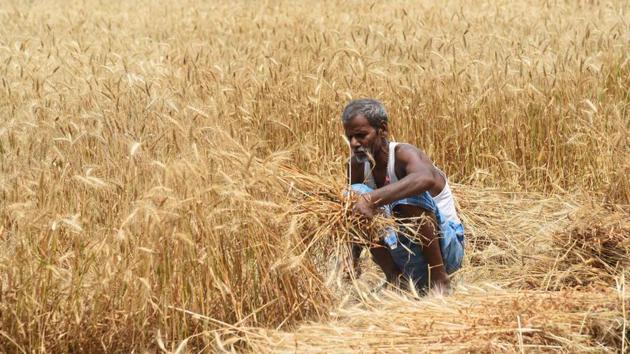Why are farm reforms not a big election issue in Bihar?
An HT analysis shows that the reason for this could be that Bihar’s agriculture is among the most low-income, low-cost operations in the country, and does not allow more than subsistence level earnings.
Half (49%) of Bihar’s workforce is employed in agriculture, according to the Periodic Labour Force Survey (PLFS) 2018-19. This is the fifth highest among major states, after Chhattisgarh, Madhya Pradesh, Rajasthan, and Uttar Pradesh. The all-India share of agriculture in employment is 42.5%. Yet, farm related issues do not seem to be getting much traction in the elections. In fact, the Opposition, especially the Rashtriya Janata Dal (RJD)-led alliance, is focussing on the issue of providing jobs and preventing migration, targeting the segment which does not want to continue in farming. The Bharatiya Janata Party (BJP) has tried to outdo the RJD by promising a higher number of jobs in its manifesto. An HT analysis shows that the reason for this could be that Bihar’s agriculture is among the most low-income, low-cost operations in the country, and does not allow more than subsistence level earnings.

Click here for complete coverage of Bihar assembly election 2020
Bihar has among the smallest land-holdings in India
Data from the 2012-13Land and Livestock Holdings Survey conducted by the National Statistical Office (NSO) shows that average land holding size in rural Bihar (the survey was limited to rural areas) is just 0.242 hectares, the fourth smallest among the 29 states in 2012-13, after Goa, West Bengal, and Kerala. The Situation Assessment Survey (SAS) in agriculture conducted during the same period also shows that Bihar has the third highest share of agricultural households owning less than a hectare of land among 18 major states for which data is available. The SAS defines agricultural households as households receiving at least Rs 3,000 worth of value of produce from agriculture activities in the last 365 days with at least one member self-employed in agriculture in the usual status.
That Bihar has among the smallest land-holding size is a statistic which is often forgotten given Bihar’s history of having seen violent land conflicts which were polarised along caste lines. To be sure, the roots of social unrest around land come from the fact that socially dominant groups have a disproportionate share among the large landowners. The SAS data makes this clear. Those not belonging to the Scheduled Castes (SC), Scheduled Tribes (ST), and Other Backward Classes (OBC) had a share of 17% among all agricultural households in Bihar. However, their relative share in land -- share in land owned divided by share in population -- is much higher for large tracts of land. In landholdings of size 1-2 hectares, the relative share of such households is 1.3. This increases to 5.7 for landholdings of size greater than 10 hectares. The corresponding all India numbers are 1.04 and 1.65.
Agriculture in Bihar is a low-cost, low-income, high deficit enterprise
The SAS report gives details about expenses incurred on crop production in the states. Bihar had the fifth lowest average expense on farming among major states. This, when read with the fact that the average agricultural household in Bihar also receives among the lowest value of output for its products among states, underlines the low-level equilibrium trap which characterizes the farm-economy in Bihar. When it comes to cost of growing crops, farmers in Bihar spend the lowest on interest payments, animal labour and plant protection chemicals compared to the average Indian farmer, while the spending on irrigation is significantly higher than the all-India average.
The high spending on irrigation is primarily a result of private investment in sinking tube wells for irrigation. 2010-11 agricultural census data (latest available figures) available in the Centre for Monitoring Indian Economy (CMIE) database shows that the share of land irrigated by tube-wells is significantly higher in Bihar (64.8%) than the all-India average (45%). This, given the fact that the state has been facing a depletion of ground water tables, is not an encouraging trend.
Given the low incomes in farming, agricultural households run a very high deficit in Bihar and have the highest consumption expenditure to income ratio among 28 states in the SAS. This is despite the fact consumption expenditure of the average Bihari agricultural household was the 6th lowest.
Agricultural reforms do not seem to have helped farm incomes in Bihar
Bihar was among the first states to abolish the monopoly of Agriculture Produce Market Committees (APMCs) in 2006, one of the three key agricultural reforms which were announced by the Narendra Modi government in May this year. While the centre’s decisions have triggered big protests in states such as Punjab and Haryana, these reforms are not much of an issue in the Bihar polls. The Bihar experience also shows that abolishing the monopoly of APMCs does not guarantee higher farm incomes. SAS data shows that share of agricultural households selling their crops to private traders (and not in Mandis) is higher than the all-India average, yet, average farm incomes are much lower in Bihar (as has been shown above).
Why are farm loan waivers not being promised in Bihar?
SAS data shows that not only does the average Bihari agricultural household have a lower outstanding value of debt; they also take it from non-institutional lenders. When read with the fact that Bihar has the highest consumption expenditure to income ratio for agriculture households in the states, it is entirely possible that a lot of lending by agricultural households could be to fulfil their consumption rather than investment requirements. These facts also mean that a farm loan waiver promise will have lower traction among agricultural households than in other states. Government farm loan waiver programmes mostly benefit borrowers who have taken loans from institutional lenders.



